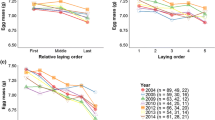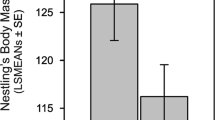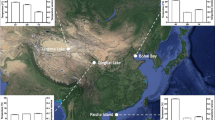Abstract
We studied egg size variation of Tengmalm's owls in western Finland during 1981–1990. The owls fed on voles whose population fluctuated in a predictable manner: low (1981, 1984, 1987, 1990), increase (1982, 1985, 1988) and peak (1983, 1986, 1986) phases of the cycle occurred every third year. Eggs were largest in the increase phase of the vole cycle, even though that voles were more abundant and egg-laying started earlier in the peak phase than in the increase phase. This suggests that owls invest mostly in egg size when vole abundance increases along with survival chances of offspring. Territory quality and female age had no effects on egg size, but egg size decreased with laying data in the increase phase of the vole cycle. Egg size was significantly positively related to the male age in the increase phase, but the opposite relationship was significant in the peak phase of the vole cycle. The partners of adult males also decreased their egg volume from the increase to the peak phase, whereas the partners of yearling males produced their largest eggs in the peak phase of the vole cycle. This suggests the importance of experience in prevailing food fluctuations. Possibly male Tengmalm's owls can adjust the intensity of courtship feeding not only in relation to the food abundance on their territories at the time of egg laying, but also to the survival prospects of their offspring. Phenotypic plasticity seems to play a substantial role, as the egg size repeatabilities of individual females and partners of individual males were low. Obviously, under cyclic food conditions, predictability and inter-generational trade-offs are important to life history traits.
Similar content being viewed by others
References
Andersson M (1976) Population ecology of long-tailed skua (Stercorarius longicaudus Vieill.). J Anim Ecol 45: 537–559
Andersson M (1978) Natural selection of offspring numbers: some possible intergenerational effects. Am Nat 112: 762–766
Ankney CD (1980) Egg weight, survival, and growth of lesser snow goose goslings. J Wildl Manage 44: 174–182
Bell G (1980) The costs of reproduction and their consequences. Am Nat 116: 45–76
Bell G, Koufopanou V (1986) In: Dawkins R, Ridley M (ed) The cost of reproduction (Oxford Surveys in Evolutionary Biology, vol. 3). Oxford University Press, Oxford pp 83–131
Boag PT, Noordwijk AJ van (1987) Quantitative genetics. In: Cooke FA, Buckley PA (eds) Avian genetics: a population and ecological approach. Academic Press, London, pp 45–78
Cabana G, Kramer DL (1991) Random offspring mortality and variation in parental fitness. Evolution 45: 228–234
Carlisle TR (1982) Brood success in variable environments: implications for parental care allocation. Anim Behav 30: 824–836
Clutton-Brock TH (ed) (1988) Reproductive success. University of Chicago Press, Chicago
Clutton-Brock TH (ed) (1991) The evolution of parental care. Princeton University Press, Princeton
Davis JWF (1975) Age, egg-size and breeding success in the herring gull Larus argentatus. Ibis 117: 460–473
Drent RH, Daan S (1980) The prudent parent: energetic adjustments in avian breeding. Ardea 68: 225–252
Endler JA (1986) Natural selection in the wild. Princeton University Press, Princeton
Falconer DS (1981) Introduction to quantitative genetics, 2nd edn, Longman, London
Finerty JP (1980) The population ecology of cycles in small mammals. Mathematical theory and biological fact. Yale University Press, New Haven
Glutz von Blotzheim UN, Bauer KM (1980) Handbuch der Vögel Mitteleuropas, vol 9 Academische Verlagsgesellschaft, Wiesbaden
Goodman D (1979) Regulating reproductive effort in changing environment Am Nat 113: 735–748
Gustafsson L (1985) Fitness factors in the collared flycatcher Ficedula albicollis Temm. Ph. D. thesis, Uppsala University, Sweden
Gustafsson L, Sutherland WJ (1988) The costs of reproduction in the collared flycatcher Ficedula albicollis. Nature 335: 813–817
Hakkarainen H, Horpimäki E (1993) The effect of female body size on clutch volume of Tengmalm's owls Aegolius funereus in varying food conditions. Ornis Fenn 70: 189–195
Hakkarainen H, Korpimäki E (1994a) Nest defence of Tengmalm's owls reflects offspring survival prospects under fluctuating food conditions. Anim Behav (in press)
Hakkarainen H, Korpimäki E (1994b) Does feeding effort of Tengmalm's owls reflect offspring survival prospects in cyclic food conditions? Oecologia 97: 209–214
Hansson L, Henttonen H (1985) Gradients in density variations of small rodents: the importance of latitude and snow cover. Oecologia 67: 394–402
Harper JL, Lovell PH, Moore KG (1970) The shapes and sizes of seeds. Annu Rev Ecol Syst 1: 327–356
Hirshfield MF, Tinkle DW (1975) Natural selection and the evolution of reproductive effort. Proc Natl Acad Sci USA 72: 2227–2231
Högstedt G (1981) Effect of additional food on reproductive success in the magpie (Pica pica). J Anim Ecol 50: 219–229
Hörnfeldt B, Eklund U (1990) The effect of food on laying date and clutch size in Tengmalm's owl. Ibis 132: 359–406
Hörnfeldt B, Carlsson B-G, Nordström LL (1988) Molt of primaries and age determination in Tengmalm's owl (Aegolius funereus). Auk 105: 783–789
Hörnfeldt B, Carlsson B-G, Löfgren O, Eklund U (1990) Effects of cyclic food supply on breeding performance in Tengmalm's owl (Aegolius funereus). Can J Zool 68: 522–530
Johnsgard PA (1988) North American owls. Biology and natural history. Smithsonian Institution, Washington
Kalela O (1962) On the fluctuations in the numbers of arctic and boreal small rodents as a problem of production biology. Ann Acad Sci Fenn A IV 66: 1–38
Klomp H (1970) The determination of clutch size in birds. A review. Ardea 58: 1–121
Korpimäki E (1981) On the ecology and biology of Tengmalm's owl (Aegolius funereus) in southern Ostrobothnia and Suomenselkä, western Finland. Acta Univ Oulu Ser A Sci Rer Nat 118: 1–84
Korpimäki E (1987) Selection for nest-hole shift and tactics of breeding dispersal in Tengmalm's owl Aegolius funereus. J Anim Ecol 56: 185–196
Korpimäki E (1988a) Diet of breeding Tengmalm's owls Aegolius funereus: long-term changes and year to year variation under cyclic food conditions. Ornis Fenn 65: 21–30
Korpimäki E (1988b) Effects of territory quality on occupancy, breeding performance and breeding dispersal in Tengmalm's owl. J Anim Ecol 57: 97–108
Korpimäki E (1988c) Effects of age on breeding performance of Tengmalm's owl Aegolius funereus in western Finland. Ornis Scand 19: 21–26
Korpimäki E (1989) Breeding performance of Tengmalm's Owl Aegolius funereus: effects of supplementary feeding in a peak vole year. Ibis 131: 51–56
Korpimäki E (1990a) Low repeatability of laying data and clutch size in Tengmalm's owl: an adaptation to fluctuating food conditions. Ornis Scand 21: 282–286
Korpimäki E (1990b) Body mass of breeding Tengmalm's owls Aegolius funereus: seasonal, between-year, site and age-related variation. Ornis Scand 21: 169–178
Korpimäki E (1992) Fluctuating food abundance determines the lifetime reproductive success of male Tengmalm's owls. J Anim Ecol 61: 103–111
Korpimäki E, Hakkarainen H (1991) Fluctuating food supply affects the clutch size of Tengmalm's owl independent of laying date. Oecologia 85: 543–552
Korpimäki E, Lagerström M (1988) Survival and natal dispersal of fledglings of Tengmalm's owl in relation to fluctuating food conditions and hatching date. J Anim Ecol 57: 433–441
Korpimäki E, Norrdahl K (1989) Predation of Tengmalm's owls: numerical responses, functional responses and dampening impact on population fluctuations of microtines. Oikos 54: 154–164
Krebs CJ, Myers JH (1974) Population cycles in small mammals. Adv Ecol Res 8: 267–399
Lessells CM, Boag PT (1987) Unrepeatable repeatabilities: a common mistake. Auk 104: 116–121
Lindén M (1990) Reproductive investment and its fitness consequences in the great tit Parus major. Ph. D. thesis, Uppsala University, Sweden
Lindström E (1988) Reproductive effort in the red fox, Vulpes vulpes, and future supply of a fluctuating prey. Oikos 52: 115–119
Löfgren D, Hörnfeldt B, Carlsson B-G (1986) Site tenacity and nomadism in Tengmam's owl (Aegolius funereus (L.)) in relation to cyclic food production Oecologia 69: 321–326
Masman D, Dijkstra C, Daan S, Bult A (1989) Energetic limitation of avian parental effort: field experiments in the kestrel (Falco tinnunculus). J Evol Biol 2: 435–455
Mikkola H (1983) Owls of Europe. Poyser, Calton
Mills JA (1979) Factors affecting the egg size of red-billed gulls Larus novaehollandiae scopulinus. Ibis 121: 53–67
Milne H (1974) Breeding numbers and reproductive rate of eiders at the sands of Forvie National Nature Reserve, Scotland. Ibis 116: 135–152
Murphy EC, Haukioja E (1986) Clutch size in nidicolous birds. Curr Ornithol 4: 141–180
Myrberget S (1977) Size and shape of eggs of willow grouse Lagopus lagopus. Ornis Scand 8: 39–46
Newton I (1979) Population ecology of raptors. Poyser, Berkhamsted
Newton I (ed) (1989) Lifetime reproduction in birds. Academic Press, London
Nisbet ICT (1973) Courtship-feeding, egg-size and breeding success in Common terns. Nature 241: 141–142
Noordwijk AJ van, Jong G de (1986) Acquisition and allocation of resources: their influence on variation in life history tactics. Am Nat 128: 137–142
Ojanen M (1983) Significance of variation in egg traits in birds, with special reference to passerines. Acta Univ Oulu Ser A Sci Rer Nat 154: 1–61
Otto C (1979) Environmental factors affecting egg weight within and between colonies of fieldfare Turdus pilaris. Ornis Scand 10: 111–116
Parsons J (1970) Relationship between egg-size and post-hatching chick mortality in the Herring gull (Larus argentatus). Nature 228: 1221–1222
Perrins CM (1965) Population fluctuations and clutch-size in the great tit Parus major L. J Anim Ecol 34: 601–647
Perrins CM (1965) The timing of birds' breeding season. Ibis 112: 242–255
Pietitäinen H, Saurola P, Väisänen R (1986) Parental investment in clutch size and egg size in the Ural owl Strix uralensis. Ornis Scand 17: 309–325
Reid WJ, Boersma PD (1990) Parental quality and selection on egg size in the magellanic penguin. Evolution 44: 1780–1786
Reznick D (1985) Costs of reproduction: an evaluation of the empirical evidence. Oikos 44: 257–267
Sinervo B (1990) The evolution of maternal investment in lizards: an experimental and comparative analysis of egg size and its effects on offspring performance. Evolution 44: 279–294
Sinervo B, McEdward LR (1988) Developmental consequences of an evolutionary change in egg size: an experimental test. Evolution 42: 885–899
Sokal RR, Rohlf FJ (1981) Biometry. Freeman, San Francisco
Stearns SC (1989) Life-history tactics: a review of the ideas. Q Rev Biol 51: 3–47
Stearns SC (1989) Trade-offs in life-history evolution. Funct Ecol 3: 259–268
Stearns SC (1992) The evolution of life histories. Oxford University Press, Oxford
Tatum JB (1975) Egg volume. Auk 92: 576–580
Village A (1983) Body weights of Kestrels during the breeding cycle. Ring Migr 4: 167–174
Washburn KW (1979) Genetic variation in the chemical composition of the egg. Poult Sci 58: 529–535
Wilkinson L (1988) The system for statistics. SYSTAT, Evanston, Illinois
Williams GC (1966) Natural selection, the costs of reproduction and a refinement of Lack's principle. Am Nat 100: 687–690
winkler DW, Walters K (1983) The determination of clutch size in precocial birds. Curr Ornithol 1: 33–68
Author information
Authors and Affiliations
Rights and permissions
About this article
Cite this article
Hakkarainen, H., Korpimäki, E. Environmental, parental and adaptive variation in egg size of Tengmalm's owls under fluctuating food conditions. Oecologia 98, 362–368 (1994). https://doi.org/10.1007/BF00324225
Received:
Accepted:
Issue Date:
DOI: https://doi.org/10.1007/BF00324225




